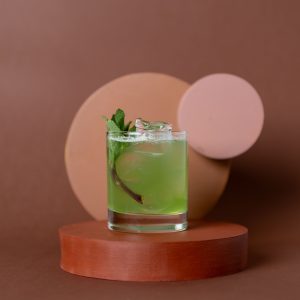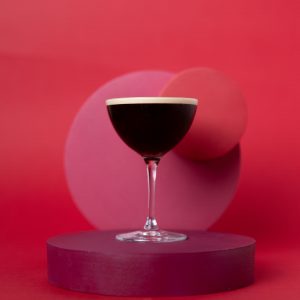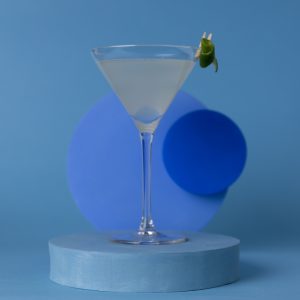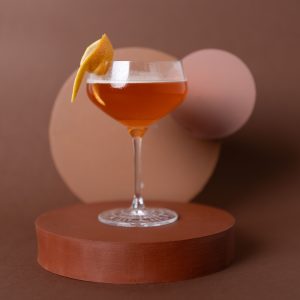Our easy-to-follow East India No.2 recipe will make the perfect summer pre-dinner drink. With Cognac, Orange Curacao Liqueur, Pineapple juice, Pineapple syrup, and Angostura Bitters, this dry yet fruity cocktail is sure to delight.
Prep time:
1 minute minute
Mixing time:
1 minute minute
Servings:
1
Calories:
195
Ingredients
- 2 oz Cognac
- ½ oz Orange Curaçao Liqueur - or Triple Sec
- ½ oz pineapple juice
- 1 bar spoon pineapple syrup
- 2 dashes Angostura Bitters
- Ice cubes
- Lemon peel and cherry - skewered (for garnish, optional)
Equipment
- Coupe or Martini Glass
- Cocktail Shaker
- Measuring Jigger
- Cocktail Strainer
- Fine strainer
- Bar spoon
Instructions
- Prep Glass: Fill a Coupe glass with ice. Give it a stir to chill it and set it aside.
- Add Bitters: Pour 2 dashes Angostura Bitters into the shaker.
- Add Pineapple Syrup: Add 1 bar spoon pineapple syrup.
- Add Pineapple Juice: Add ½ oz pineapple juice.
- Add Orange Curaçao: Measure and pour ½ oz Orange Curaçao Liqueur into the shaker as well.
- Add Cognac: Finally, add 2 oz Cognac to the mix.
- Shake Well: Fill the shaker with ice, close it, and give it a good shake (10-15 seconds).
- Strain: Take the Coupe glass and discard the ice inside. Then, using the cocktail strainer and the fine strainer, strain the shaken drink into the chilled filled glass.
- Garnish: Garnish with a lemon peel and a Maraschino cherry skewered together and serve immediately.
Notes
Substitutes:
- Cognac: If you don't have cognac on hand, you can substitute another brandy such as Armagnac or Applejack. It won't have the same depth of flavor, but it will still work in a pinch.
- Orange Curacao Liqueur: Triple Sec or Grand Marnier can be substituted for Orange Curacao Liqueur if needed.
- Pineapple Syrup: If you're out of pineapple syrup, you can use pineapple liqueur as a substitute or make your own syrup at home. There are several ways of doing that, the easiest being to combine equal parts pineapple juice and sugar over low heat. Stir well until the sugar is fully dissolved, remove from the heat, and let it cool down to room temperature before using.
- Angostura Bitters: If you don't have Angostura Bitters, try using orange bitters or lemon bitters as an alternative.
Making a Pitcher of East India No.2:
- Scale: To make a pitcher that serves 8, multiply all the ingredients by 8. That would be 16 oz of Cognac, 4 oz of Orange Curacao Liqueur, 4 oz of Pineapple juice, 1,5 oz of Pineapple syrup, and 16 dashes of Angostura Bitters.
- Mix: In a large pitcher, combine all the ingredients. Add ice and stir well.
- Serve: Strain to remove the ice, serve immediately into chilled Martini or coupe glasses, and garnish each glass with a lemon peel and a candied cherry (you can put them both on a cocktail skewer). If you have some leftovers, be sure to keep it in the fridge (make sure no ice cubes are left inside) in an airtight container.
Making it Non-Alcoholic:
- Cognac Substitute: Use a non-alcoholic brandy substitute; these are available and reasonably mimic the brandy's flavors. If you’re feeling crafty, you can also make your own brandy substitute by infusing together rooibos tea and a bunch of spices of your liking (raisins, vanilla, and cocoa beans are always a good way to start). Mix all the ingredients together, add hot water, cover, and let it infuse for at least 3h (the stronger the better, so if you have time let it infuse overnight. In that case, you can either let it rest in the fridge once the liquid has cooled down). Give it a taste, adjust the spice level if necessary, and strain it once you’re happy with the result. Stored properly (in an airtight container in the fridge), this “tea brandy” can be kept for up to a week.
- Orange Curacao Liqueur Substitute: You can use orange peel syrup as a substitute. To make your own syrup, mix together 1 part white sugar and a white part water over low heat. Stir well to dissolve the sugar, remove from the heat, and add orange peels to the syrup. Let the mixture cool down to temperature, transfer to an airtight container, and let it infuse in the fridge for at least one day. For a stronger flavor, you may add a drop of bitter orange essence to the mix. When ready to use, strain to remove the peels and store in the fridge after use.
- Proceed As Usual: Use these non-alcoholic substitutes instead of the regular ingredients, follow the original steps, and enjoy a non-alcoholic version.
Making it Vegan:
This cocktail is already vegan-friendly as it doesn't contain any animal products. Just ensure that the specific brands of alcohol you're using are vegan, as some brands may use animal products in their processing methods.What is an East India No.2?
An East India No.2 is a brandy-based tropical cocktail made of Cognac, Orange Curacao, Pineapple juice, Pineapple syrup, and Angostura Bitters. It’s relatively easy to make as it only requires mixing the ingredients in correct proportions without any complex techniques or steps involved. This cocktail stands out for its unique blend of flavors – the pineapple sweetness perfectly complements Cognac and bitters’ robustness.

What is an East India No.2 made of – The ingredients
Get ready to make an East India No.2 with these ingredients:
- Cognac forms the cocktail’s base, providing a rich and complex flavor.
- Orange Curacao Liqueur: A liqueur made from the dried peel of bitter oranges, Orange Curaçao contributes a citrusy, slightly bitter note.
- Pineapple Juice: Pineapple juice provides a tangy, fruity flavor, adding a refreshing element to the cocktail.
- Pineapple Syrup: This sweet syrup, made from pineapple juice, enhances drinks with a bright, tropical sweetness.
- Angostura Bitters: Adds depth and complexity to the cocktail, balancing out the sweetness.




















